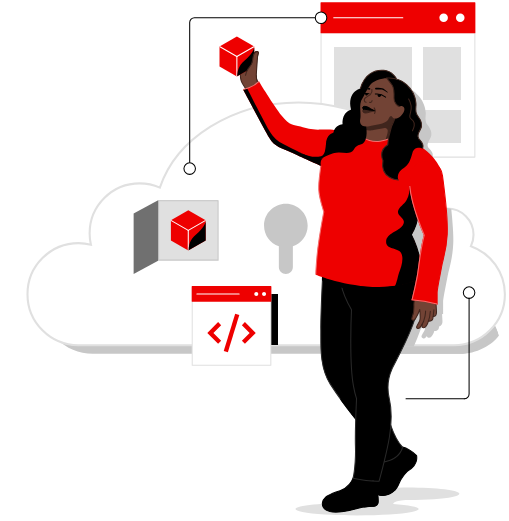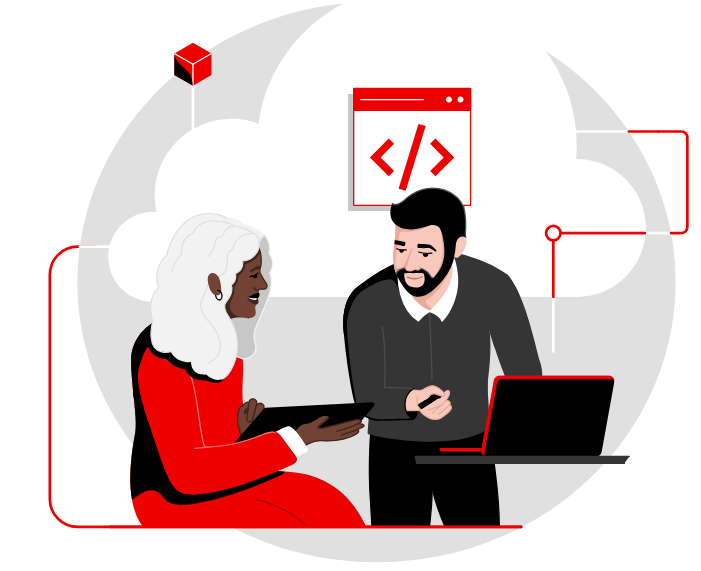Discover the business benefits of Red Hat Enterprise Linux on Microsoft Azure
Enterprises are embracing the cloud
Cloud computing is among the most viable options for organizations to maintain stability and increase efficiency in rapidly evolving and competitive markets. Statistics show that public cloud continues to gain traction as organizations migrate to it to foster innovation and agility, adapt to market changes and modernize existing systems, as well as benefit from its scalability, cost optimization, and security features.
Cloud migration helps organizations address on-premise challenges and unlock cloud benefits.
Common on-premise challenges
Manually intensive and time-consuming processes.
Inefficient license management, resulting in excess license costs.
Inconsistent reliability and effectiveness, resulting in downtime.
Limited scalability.
Cloud migration advantages
Increased scalability and flexibility.
Improved customer experience.
Cost savings over time and freeing of resources to focus on innovation.
Offloading the burden of managing and maintaining physical infrastructure.
Prior to Red Hat Enterprise Linux on Microsoft Azure, business units would request for on-premise servers which would take 2 weeks to a month to deploy depending on what the requirements were. The entire process was time-consuming as there’s all these things that we undergo like reviewing capacity and other planning that is behind it.
82% of enterprise cloud decision makers are adopting public cloud1
49% of enterprise workloads are run in public cloud environments2
48% of enterprise data is hosted in public cloud environments2
58% of organizations say migrating more workloads to the cloud is a top initiative2
The benefits of a hybrid cloud approach
According to IDC, cloud spending now outpaces spending on platforms, infrastructure, and applications. By 2025, 60% of infrastructure, security, data, and network offerings will need cloud-based control platforms to satisfy enterprise demands for automation and operating cost reductions.4
Even so, moving to the cloud can create additional IT complexity, with 78% of organizations stating lack of skills and resources to be a challenge.2 Careful planning is required to get the most from cloud investments while avoiding potential security risks, operational inefficiencies, and budget overruns.
Organizations are increasingly using public cloud resources within hybrid cloud strategies to benefit from the advantages of both on-premise infrastructure and cloud services. This approach allows them to:
- Maintain control over critical data and applications.
- Meet regulatory requirements.
- Unlock licensing flexibility and easier procurement routes.
Security, controlling costs, effectively managing resources, and guaranteeing resource availability are important considerations when building a hybrid environment. A consistent operating system (OS) across datacenter and cloud environments can help overcome the complexities and simplify the journey.
73% of organizations have a hybrid cloud strategy in place2
We’ve taken the time to use cloud-native technologies wherever possible. And so far it has worked out well for us. We’ve realized a cost savings benefit of more than 20% compared to our previous on-premise setup as of now.
5 considerations for successful cloud migration
Being strategic is more important than being fast when migrating to the cloud. Whether you’re in the midst of a cloud transformation or just getting started, it’s important to consider what’s working for others, what’s hindering your progress, and whether changes to your cloud strategy can help you excel. Improved automation, agility, and customer experience—not rapid workload migration—are the true indicators of success.
1. Know your cloud objective
It’s essential to know your organization’s motivations for moving to a cloud environment. A lack of organizational alignment on the reasons to migrate can create obstacles to cloud migration success.
While there may be many motivations, your main objective needs to be obvious. It might be retiring a datacenter to reduce costs, enhancing business continuity, modernizing applications to boost revenue, or introducing new cloud-native architectures.
2. Take a cloud-smart approach
It’s important not to “lift and shift” everything as is during your transition to the cloud. This approach might seem easy, but it risks carrying over existing errors and adding complexity. Instead, take a more methodical and strategic approach to modernization.
Reconsider everything, keep what works, replace what doesn’t, and discard the rest. Then, migrate only the components that your business requires.
3. Gain control of hybrid cloud complexity
Security, management, portability, and life cycle planning start with your OS. It forms the foundation for your entire environment.
Your ability to scale flexibly, maintain availability, and deliver resilient services is greatly influenced by your choice of Linux® OS. Standardizing on a single operating foundation across your datacenter and cloud environments can greatly simplify your path to the cloud.
Rather than splitting operations and management into multiple domains, your teams can use a single set of tools and platforms to deploy, run, and move applications and workloads across multiple environments while maintaining a security focus.
4. Streamline cloud security across your environments
As cloud adoption grows, security continues to be a leading concern, with 81% of organizations citing it as a top cloud challenge.2
Consistency is at the core of security and compliance best practices in any environment. To protect your business, you need the same level of security policy and access controls in your cloud environment that you have on-site in your datacenter.
With a common OS across both environments, you don’t have to worry about varying setups.
5. Optimize workloads
The cloud has made it possible for workloads to be scaled on-demand, but with auto-scalability comes a significant chance of using more capacity than required, which runs up costs.
Implementing code governance and infrastructure testing helps avoid this type of inadvertent budget overrun.
Advance your cloud journey with a hybrid cloud environment from Red Hat and Microsoft
Red Hat® Enterprise Linux provides a consistent operating foundation for hybrid and multicloud environments, so you can run applications where it makes the most sense and choose the best cloud provider for your needs. Microsoft Azure’s public cloud platform provides the ability to build, manage, and run applications in the cloud, and provide services on-premise and at the network edge. Red Hat Enterprise Linux is an endorsed Linux distribution on Microsoft Azure.
Together, Red Hat Enterprise Linux and Microsoft Azure provide a comprehensive, flexible, and open solution for organizations ready to start their cloud migration.
With Red Hat Enterprise Linux on Microsoft Azure, organizations can quickly deploy a security-focused, reliable, and flexible hybrid cloud environment that helps position them for success in fast-changing, competitive markets. This joint solution can help organizations:
- Quickly launch and scale applications, and improve reliability, security, and performance with tested and certified interoperability across on-premise and cloud environments.
- Protect data, applications, and infrastructure with advanced, integrated security features that work across hybrid environments.
- Integrate traditional on-premise applications and cloud-native workloads with a consistent foundation.
- Streamline management with unified tools and visibility across cloud and on-premise environments.
With integrated support from both companies, migrating to Red Hat Enterprise Linux on Microsoft Azure is a simpler experience. Additionally, organizations with committed spend for Microsoft Azure can use it to deploy Red Hat Enterprise Linux on Microsoft Azure.
There are a number of reasons that sold us. First, we have that flexibility to use our Red Hat subscriptions on Azure so we can mix and match, which is huge for us. Second, we have guaranteed compatibility with Microsoft running Red Hat Enterprise Linux on [Microsoft] Azure. Third, we have access in the different markets, so our facilities can get access to core systems that are locally deployed.
The 2024 Forrester Total Economic Impact™ study found enterprises using Red Hat Enterprise Linux on Microsoft Azure realized the following benefits3:
85% reduction in outage downtime
80% reduction in datacenter spend
60% reduction in legacy solution costs
40% FTE reallocation towards valueadd business initiatives
192% ROI over 3 years
Payback in under 6 months
A joint solution that supports your business initiatives
With Red Hat Enterprise Linux on Microsoft Azure, you can unlock the full potential of an open hybrid cloud approach to maximize return on investment (ROI), boost performance and business resilience, and manage risk so you can grow your customer base and revenue as an industry leader. Whatever your reasons for migrating to the cloud, discover the multiple benefits that Red Hat Enterprise Linux on Microsoft Azure can provide.
Simplified migration and management
Operating efficiently and effectively across large hybrid and multicloud landscapes can be complex. Red Hat Enterprise Linux on Microsoft Azure gives you choice and flexibility. It scales without sacrificing security or resiliency, and provides a consistent experience across hybrid and multicloud environments.
Achieve consistency at scale across on-premise, cloud, and edge environments
Red Hat Enterprise Linux on Microsoft Azure simplifies migration, helping you get to the cloud more rapidly and with less risk—without having to change your OS.
IT and development teams can continue to use their current skills, processes, and tools to administer and automate environments across clouds and on-premise, without extensive delays from retraining or other modifications.
Manage workloads across on-premise, cloud, and edge environments
As workloads move out of the datacenter and into a cloud and out to the edge, monitoring and managing them becomes increasingly complex.
Red Hat Insights (included with Red Hat Enterprise Linux subscriptions) and Azure observability and management tooling provide the ability to manage workloads from onpremise to the edge, and address key IT challenges around vulnerability, compliance, provisioning, and patching.
Integration of Red Hat solutions with Azure Arc—a solution that extends Azure capabilities beyond the Azure cloud platform— allows for centralized management of Red Hat Enterprise Linux infrastructure deployments at scale.
Free up staff to create value
Red Hat and Microsoft solutions vastly simplify the cloud procurement, consumption, maintenance, and management processes to reduce cost and boost productivity.
Migrating to Red Hat Enterprise Linux on Microsoft Azure can reduce the need for manual infrastructure management by automating updates and patches, simplifying backups and disaster recovery, and reducing maintenance and monitoring efforts, making it possible to reallocate staff to focus on value-add business initiatives.
The Forrester Total Economic Impact study found that migrating to Red Hat Enterprise Linux on Microsoft Azure gave organizations the continued reliability of Red Hat Enterprise Linux with the addition of necessary tools and infrastructure to maintain business continuity and enhance resiliency in their workloads.
By integrating on-premise infrastructure with public cloud services, these organizations became more agile and costefficient while maintaining control over sensitive data and meeting regulatory requirements.3
A focus on security and compliance
Security remains a top cloud challenge for 81% of enterprises.2 Red Hat Enterprise Linux on Microsoft Azure has built-in operating security features like live kernel patching, security profiles, security standards certification, and a trusted software supply chain to help you meet today’s high security and compliance expectations.
These advanced security features help you to reduce risk, maintain a security-focused operating environment, and better protect your organization’s most important data. Within Microsoft Azure, you can turn on security management and threat protection for Red Hat Enterprise Linux as a default. These settings deliver built-in behavioral analytics and use machine learning to identify attacks and zero-day exploits.
In addition, both Red Hat Enterprise Linux and Microsoft Azure are certified to key government and industry standards, allowing you to use them confidently in highly regulated environments.
Integrated tools
- Ensure compliance with built-in scanning and remediation for Microsoft Azure and Red Hat Enterprise Linux.
- Deploy consistent, hardened images across Microsoft Azure and other environments with Red Hat image builder.
Advanced authentication and encryption
- Verify system integrity across environments with remote attestation.
- Protect your data in the cloud with advanced encryption capabilities.
Continuous validation
- Implement zero trust architectures with built-in identity and access management.
- Streamline security configuration and management with system roles.
We’ve been able to build a level of disaster recovery and business continuity that really wasn’t possible in an on-premise datacenter.
Integrated into Red Hat Enterprise Linux, Red Hat Insights is a predictive analytics tool that works across on-site and cloud environments—including Microsoft Azure—allowing you to manage and optimize both environments from a single interface. Its compliance service helps you track your organization’s adherence to compliance requirements across your environments and provides remediation guidance.
Integrated support and expertise
With Red Hat Enterprise Linux on Microsoft Azure, you are backed by Red Hat’s award-winning support in coordination with Microsoft’s support teams to help you successfully accomplish your goals. You can spend less time solving support issues and instead refocus staff on more strategic tasks.
This complete support experience features multilingual engineers across multiple regions, colocated staff from both companies, an integrated ticketing system, and a streamlined, coordinated escalation and resolution process. Additional support is available from Red Hat and Microsoft’s partner ecosystem.
Control over cloud spend
Red Hat and Microsoft Azure offer multiple purchasing options, giving you the flexibility to choose whatever best fits your organization’s procurement processes.
You can decide which company you purchase from and how; for example, you can pay Red Hat for Red Hat Enterprise Linux subscriptions and Microsoft Azure for virtual machines, or pay Microsoft for both with unified billing or pay-as-you go-pricing.
Buy subscriptions from Red Hat
Purchase subscriptions from Red Hat and use them on site or on Microsoft Azure via Red Hat Cloud Access.
Purchase instances from Microsoft
Obtain Red Hat Enterprise Linux instances from the Azure Marketplace. You can use Microsoft Private Offers for specific solution requirements with customized terms and pricing that counts towards Microsoft Azure Consumption Commitment (MACC) commitments.
Use programs and discounts to optimize costs
MACC: This committed spend can be used for Red Hat Enterprise Linux, helping you enhance your existing environment with no additional procurement approvals.
Azure Hybrid Benefit: Applying Azure Hybrid Benefit for Linux with reserved instances results in savings of up to 76% over standard pay-as-you-go pricing.5
Red Hat Hybrid Committed Spend program: Draw down against a Red Hat commitment for both on-premise and cloud deployments. This program spans cloud providers and can be used in conjunction with MACC.
Easy migration from CentOS Linux or other Linux distributions
Organizations that use CentOS Linux or other community-based, self-supported Linux distributions face a choice of what to do if or when those distributions are discontinued. While implementing a new operating system may seem tedious, it also presents an opportunity to reassess your organization’s needs and choose a platform that will better support your cloud strategy, now and in the future. Standardizing on the right Linux platform can help you avoid managing multiple OSes, security risks, cloud vendor lock-in, service disruption, and cost escalation.
Migrating to fully supported Red Hat Enterprise Linux on Microsoft Azure provides a predictable 10-year life cycle and a straightforward migration that results in a deployment with a very similar user experience to CentOS Linux. Because CentOS Linux was derived from sources published by Red Hat, you can continue to use many of the same skills, techniques, and elements while gaining the features, tools, support, and value you need to be successful in the cloud.
To help CentOS Linux users migrate to Red Hat Enterprise Linux and maintain consistency in their environments, Red Hat has created Red Hat Enterprise Linux for Third Party Linux Migration*, a competitively priced offering available on Azure Marketplace. It includes:
A significantly reduced price subscription for Red Hat Enterprise Linux.
Convert2RHEL tooling to convert inplace instances of CentOS Linux 7 to Red Hat Enterprise Linux 7.
Up to 4 years of extended life cycle support once converted to Red Hat Enterprise Linux 7.
Red Hat consultants bring expertise and best practices to streamline your migration from CentOS Linux to Red Hat Enterprise Linux. In under 2 weeks, they can provide a personalized framework for effective planning and analysis, facilitating the conversion of systems from CentOS to supported Red Hat Enterprise Linux, whether on Azure or on-premise that want to migrate to Azure. Learn more.
*The offer is also available for SUSE Linux Enterprise Server, Oracle Linux, Rocky Linux, and Alma Linux users.
The Forrester Total Economic Impact study found that integrated support provided by Red Hat and Microsoft delivers smooth collaboration and joint troubleshooting. It provides organizations with a single point of contact for comprehensive support and issue resolution, enhancing the overall support experience and reducing complexities.3
You’re not paying for FTEs to sit in a room and watch that hardware or to be on call to be able to support that hardware. In Azure, you can log on from anywhere and be able to support that.
84% of organizations cite managing cloud spend as their top cloud challenge2
With Azure Marketplace, the actual time to market is much faster because you’re not trying to come up with solutions. The solutions are already there for you. You just use the native tools to be able to migrate and build out and those are tools that we are already familiar with.
An optimized foundation for SAP
The SAP® landscape is changing: SAP customers currently running SAP applications and workloads on a non-SAP database must migrate to SAP HANA® and SAP S/4HANA® by 2027. Many organizations are already preparing for this transition while also optimizing their environment to support additional digital transformation initiatives.
Red Hat Enterprise Linux for SAP Solutions combines the reliability, scalability, and performance of Red Hat Enterprise Linux with content specific to operating SAP landscapes.
Microsoft Azure forms a powerful and scalable cloud foundation for memory-intensive SAP HANA workloads and supports larger public cloud estates running SAP HANA.
The combination of SAP-certified Red Hat Enterprise Linux for SAP Solutions and Microsoft Azure delivers key capabilities to support your SAP environment, including:
- Near zero downtime maintenance (nZDTM).
- The speed to access the information and insight you need to make better decisions to advance your business.
- Predictive analytics to proactively detect risks and mitigate responses by automatically remediating potential issues.
- Enhanced focus on compliance, governance, and security.
- Automation to eliminate error-prone, time-consuming manual tasks, resulting in a robust, security-focused, and easy-tomanage environment for SAP workloads.
- Minimal friction from Day 0 to Day 1. Additionally, Red Hat, SAP, and Microsoft offer a simplified, hassle-free support model that covers your entire environment with comprehensive, integrated, global service.
The way this tool is built, any member of a SAP Basis team can upgrade a standalone system without being afraid of breaking things. It is quick to learn, easy to use, and flexible for different workloads and target release versions.
Broaden your modernization with Red Hat and Microsoft’s extensive portfolio
Forward-thinking organizations want to use new technology to further innovation. But increasing complexity is stifling the ability to make an impact. Organizations need open and integrated platforms and ecosystems that allow them to quickly capitalize on new opportunities.
No matter where you are in your digital transformation journey, Red Hat and Microsoft can help you gain control of hybrid cloud complexity, embrace cloud-native application development, and succeed in fast-moving competitive markets. Our partnership doesn’t force IT organizations to leave behind existing applications, but allows for a strategic migration, rearchitecting, or refactoring on your terms while helping you embrace automation and cloud-native application development.
Accelerate application development
Innovative applications are at the core of modern business, connecting organizations, partners, and customers to deliver valuable user experiences for all. By rapidly building, deploying, updating, and scaling applications in a securityfocused, repeatable manner across hybrid environments, you can unlock new possibilities for your business.
Microsoft Azure Red Hat OpenShift® gives you a trusted, reliable, cloud-based foundation for transforming application development and delivery, which helps your organization:
- Create a consistent, streamlined, and full-featured experience for developers.
- Reduce support costs and increase operational efficiency.
- Streamline and rapidly provide the services your staff need to innovate and develop high-value applications.
- Accelerate deployment and time to value with joint extensive experience, migration planning assistance, and managed operations.
- Integrate Azure cloud services, developer tools, and 3rd-party products as needed.
Create an automation strategy
IT automation can help you more efficiently move to the cloud and manage cloud environments at scale.
Red Hat Ansible® Automation Platform on Microsoft Azure helps you adopt an organization-wide approach to automation, so your company can manage complex environments more readily, gain visibility into operations, and integrate new technology and processes more effectively. It can help:
- Connect your entire hybrid cloud environment with a consistent operational framework and reusable workflows.
- Boost productivity and decrease operational costs.
- Streamline and accelerate operations, including application development and delivery.
- Reduce errors and misconfigurations that result in downtime and compliance issues.
- Unburden staff to focus on high-value, rewarding projects.
Our Red Hat stack on Microsoft Azure, a proven solution for cloud services, has enabled us to become faster and create a hybrid cloud infrastructure that meets our needs. With Red Hat OpenShift Container Platform on Microsoft Azure, for example, we can start implementing a new application immediately, without waiting for any infrastructure, allowing us to produce results in just a few days and have a minimum viable product after just several weeks.
How to get started
We’ve made it easy for you to implement Red Hat Enterprise Linux on Microsoft Azure in a way that best fits your needs.
Already have Red Hat Enterprise Linux?
Keep all the benefits of your Red Hat subscription—including our award-winning support—while operating on Microsoft Azure with Red Hat Cloud Access.
Already use Microsoft Azure?
You can use your Microsoft Azure committed spend toward the purchase of Red Hat Enterprise Linux on the Microsoft Azure marketplace.
New to both?
Check out all your options to get started in the cloud with Red Hat Enterprise Linux and Microsoft Azure.
[Red Hat Enterprise Linux on Microsoft Azure] gives us a level of comfort in the fact that we’re using an industry-standard supported software platform.
Sustar, Lee, and Kathryn Bell. “Public Cloud Market Insights, 2023,” Forrester, 27 Nov. 2023.
Flexera. “Flexera 2024 State of the Cloud Report,” March 2024.
Forrester Consulting study, commissioned by Red Hat and Microsoft. “The Total Economic Impact™ Red Hat Enterprise Linux On Microsoft Azure,” Jan. 2024
IDC. “Worldwide Whole Cloud Forecast, 2022-2026,” Dec. 2022. (Subscription required.)
Based on 1 standard D2s v4 Azure VM with RHEL or SLES subscription in the east U.S. region running at a pay-as-you-go rate vs a reduced rate for a 3-year Reserved Instance. Based on Azure pricing as of June 2023. Prices subject to change. Actual savings may vary based on location, instance type, or usage.




